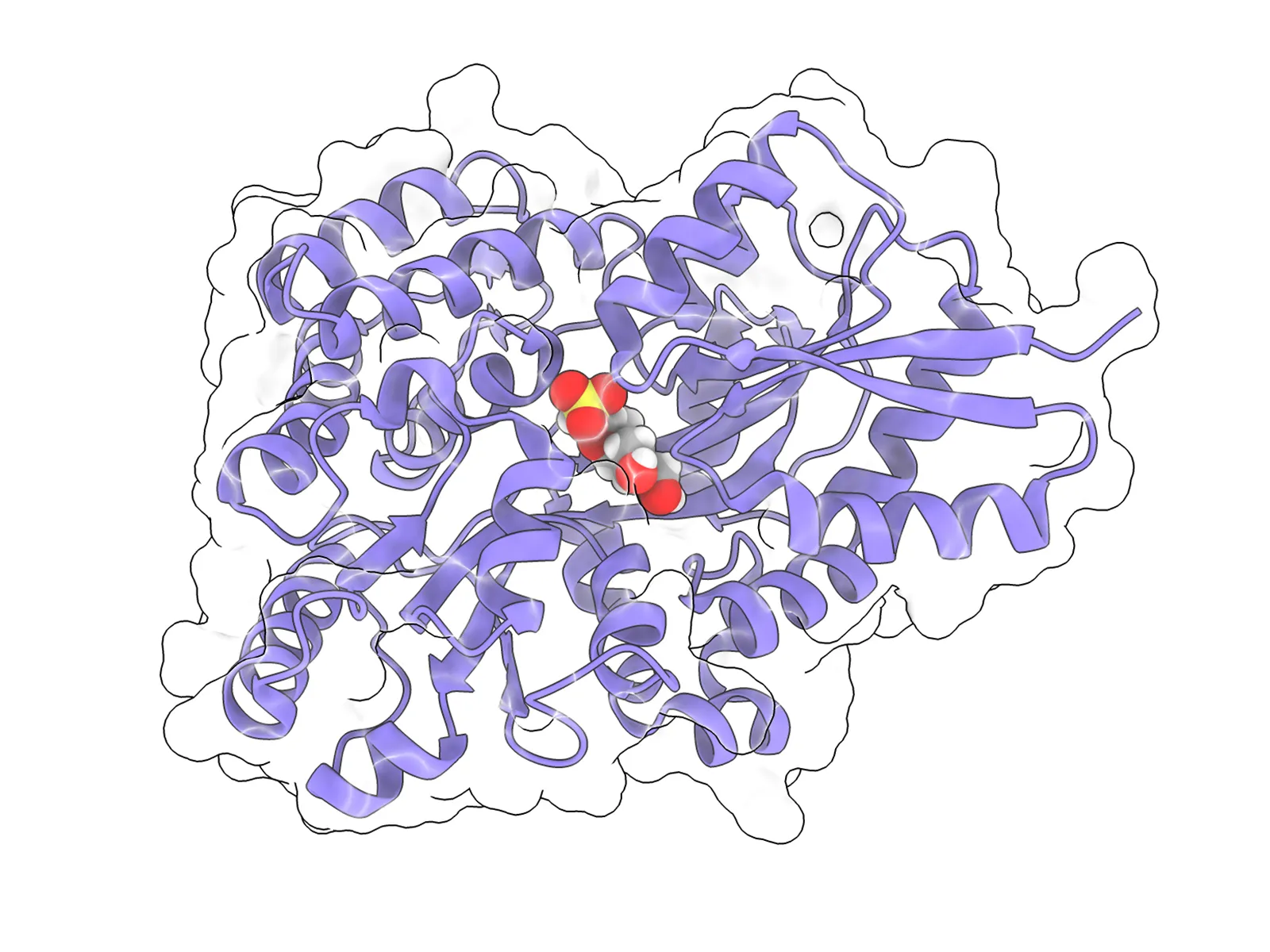Winner: 2024 Chemistry Biology Interface Horizon Prize: Rita and John Cornforth Award
Biosulfur Recyclers
University of Melbourne; WEHI; University of York
For developing an understanding of sulfosugar metabolism and the discovery of new enzymes and pathways of sulfur recycling.

The team's goal is to understand how tiny organisms break down sulfur-containing sugars called sulfosugars. In doing so, they are shedding light on a crucial but poorly understood ‘recycling’ process in nature.
Biography
Sulfur is a critical element for life on Earth and is one of the four macronutrients along with nitrogen, phosphorus, and potassium. It is found in proteins and special sugars that help plants capture sunlight (photosynthetic organisms). Because sulfosugars are produced by almost all photosynthetic organisms, they are extraordinarily abundant, with an estimated 10 billion tonnes generated and broken down each year. But, despite their prevalence, how they get broken down by nature has remained a mystery.
The team’s work has made three significant contributions to uncovering this mystery.
1) They studied the breakdown pathway of a sulfosugar called sulfoquinovose. This pathway is similar to how regular sugar (glucose) breaks down (glycolysis) and has therefore been named sulfoglycolysis.
2) The team discovered a new pathway for the breakdown of sulfoquinovose that, unlike the sulfoglycolysis pathway, directly targets the unique carbon-sulfur bond in sulfoquinovose.
3) They discovered a new family of enzymes that release sulfoquinovose from sulfolipids (the form they exist in within plants). This step is crucial before the breakdown process can begin. While this reaction normally involves water (hydrolysis), the team discovered a class of enzymes that use a hidden chemical reaction to achieve the same result.
A multinational, multidisciplinary collaboration, with team members from Australia, England and Japan.
Spencer Williams: "I am ecstatic that our team’s work is being recognised by this prestigious award. I am extremely proud of everyone in the team: the work could not have been done without this brilliant group of dedicated scientists with their incredible breadth of skills."
Biosulfur Recyclers
The team
Palika Abayakoon, PhD student, University of Melbourne
David B. Ascher, Professor, University of Melbourne
Bruna M. da Silva, PhD student, University of Melbourne
Gideon Davies, Professor, University of York
Ruwan Epa, PDRA, University of Melbourne
Ethan D. Goddard-Borger, Professor, WEHI
Sam Hart, Cryo-EM and X-ray Technician, University of York
Akira Ishihama (deceased), Professor, Hosei University
Michael A. Järvå, PDRA, WEHI
Yi Jin, PDRA, University of York
Arashdeep Kaur, PhD student, University of Melbourne
James P. Lingford, RA, WEHI
Runyu Mao, PhD student, WEHI
Malcolm J. McConville, Professor, University of Melbourne
Janice W.-Y. Mui, PhD student, University of Melbourne
Masahiro Nakano, Assistant Professor, Kyoto University
Marija Petricevic, PhD student, University of Melbourne
Isabelle Pickles, PDRA, University of York
Sacha J. Pidot, Senior Lecturer, University of Melbourne
Douglas E.V. Pires, Associate Professor, University of Melbourne
Eleanor C. Saunders, PDRA, University of Melbourne
Nichollas E. Scott, Associate Professor, University of Melbourne
Mahima Sharma, PDRA, University of York
Tomohiro Shimada, Associate Professor, Meiji University
Niccolay Madiedo Soler, PDRA, WEHI
Alexander J.D. Snow, PhD student, University of York
Johan Turkenburg, X-ray Facilities Manager, University of York
Spencer Williams, Professor, University of Melbourne
Yunyang Zhang, MSc student, University of Melbourne
Q&A
What was your role within the team?
Nick Scott: My team led the proteomic analysis of different bacterial strains grown on sulfosugars and aided in identifying the pathways responsible for breaking down these sugars.
Ethan Goddard-Borger: I was a group leader involved in the design of experiments.
Spencer Williams: I am a group leader who has been involved at all levels, particularly ideation, recruiting and coordinating with collaborators, resourcing and reporting. It’s a lot of fun to work with such a diverse group of excellent junior and senior scientists.
Mahima Sharma: With the structural biology team in York, I looked at 3D structures of enzymes from these microbial pathways and explained how this special sulfosugar (and its intermediates) fit inside the reaction centres in the enzymes.
What were the biggest challenges in this project?
Spencer Williams: The biggest challenges have also been the most rewarding. This includes the breadth of techniques we have had to master to uncover intricate details of how microbes degrade organosulfur.
Ethan Goddard-Borger: Coordinating and integrating the diverse expertise of groups spread around the world is a challenge but it is also immensely rewarding to see it all come together to deliver results.
What different strengths did different people bring to the team?
Arashdeep Kaur: Each team member brings unique strengths to the table. Individual team members bring diverse perspectives and experiences that contribute to creativity and innovation within the team. These strengths complement each other, fostering collaboration and driving the team towards success.
Why is this work so important and exciting?
Spencer Williams: Sulfoquinovose is incredibly abundant in photosynthetic organisms, yet most people have never heard of it. It is exciting to discover new enzymes and pathways for its breakdown and to grow the awareness of its importance to the biogeochemical sulfur cycle.
Ethan Goddard-Borger: This work is important because it bridges a major gap in our understanding of environmental sulfur cycles. It is fundamental to understanding microbial communities in places as diverse as soil and the colon.
Where do you see the biggest impact of this technology/research being?
Nick Scott: One of the biggest impacts of being part of these projects has been improving our tools for identifying changes in operon-associated proteins from proteomic data. Working with the team has really allowed us to streamline this operon-centric analysis, creating a number of useful scripts we now use across a range of projects.
Ethan Goddard-Borger: One of the most exciting future applications of this work may be in the use of sulfosugars as ‘targeted prebiotics’ to selectively promote the proliferation of beneficial bacteria in the gastrointestinal tract.
Spencer Williams: The near-perfect recycling of chemical nutrients is necessary for the persistence of life on Earth. Understanding the pathways used by nature to achieve the recycling of sulfur helps us to understand the nutrient cycles that support agriculture, aquaculture and allow us to be better stewards for the natural environment
How will this work be used in real life applications?
Ethan Goddard-Borger: One of the most exciting future applications of this work may be in the use of sulfosugars as ‘targeted prebiotics’ to selectively promote the proliferation of beneficial bacteria in the gastrointestinal tract.
How do you see this work developing over the next few years, and what is next for this technology/research?
Isabelle Pickles: As we understand more of the basic science of sulfoquinovose-related biology in nature, we are able to apply this knowledge to pressing questions. This can be as diverse as microbial health in agriculture and the human gut, and in carbohydrate processing for industrial purposes.
Mahima Sharma: Sulfoquinovose is widespread all around us – we expect further microbial pathways to be discovered adding to our fundamental knowledge of biological sulfur cycle, of particular interest are SQ pathways prevalent in gut bacteria, as well as in agriculturally-relevant nitrogen-fixing bacteria.
What inspires or motivates your team?
Arashdeep Kaur: What inspires me is the prospect of continuous learning and involvement in impactful projects that contribute to the scientific community.
Yunyang Zhang: People pursue careers in science and academia generally because of inherent curiosity, the desire to comprehend the world, and their thirst for knowledge. The prospect of making discoveries, solving complex problems, and advancing human understanding can be satisfying for scientists.
Ethan Goddard-Borger: There are many motivations driving the team. Curiosity and a thirst for knowledge is one, the thrill of being the first to see or understand something is another. And, of course, the desire to use one’s skills to improve the world is ever-present.
Mahima Sharma: Seeing is believing, uncovering new reactivities and revealing atomic-level details of biomolecules (enzymes) is at the heart of what we do at York structural biology lab and what keeps us going. With all the technological advances we are seeing in the past years, it is a very exciting time to be a structural biologist.
What is the importance of collaboration in the chemical sciences?
Spencer Williams: Quite simply, to make the biggest impact in research, you need both breadth and depth, and this can only be achieved with a diverse team.
Nick Scott: Collaboration is critical for tackling large, ambitious projects, but more than that, I believe collaboration makes you a better scientist. It's easy to master techniques when you're applying them under a strict framework, but when you start to work with teams across fields, especially with diverse samples, having a deep understanding of techniques becomes essential for delivering results for the team.
Yunyang Zhang: Collaboration in the sciences is vital as it brings together diverse expertise and perspectives to tackle complex problems. Everyone brings unique sets of strengths and skills that complement and/or reinforce their colleagues, making collaboration essential in the sciences. By pooling resources and sharing knowledge, researchers can achieve more significant breakthroughs and accelerate the pace of discovery.
Isabelle Pickles: Collaboration in science, especially between teams across the world, helps you to see the big picture. Challenging problems are more easily solved when people from diverse backgrounds can come together.
What does good research culture look like or mean to you?
Ruwan Epa: Good research culture fosters an environment of curiosity, collaboration, and integrity, where researchers explore new ideas and pursue knowledge. In a good research culture, open communication and tolerance of alternate viewpoints are valued. It also prioritizes inclusivity, ethical conduct, and transparency.
Yunyang Zhang: Openness, transparency, and intellectual integrity are fundamental pillars of a good research culture. More importantly, collaboration and fostering a supportive environment where diverse perspectives are valued are the keys to significant scientific discoveries. Engaging with all team members and embracing inclusivity are integral to providing an environment that is willing to share and safe to share
How are the chemical sciences making the world a better place?
Arashdeep Kaur: Chemistry plays a crucial role in shaping our modern world and influencing various aspects of daily life. From tackling pressing challenges in health, medicine and environmental sustainability to driving technological innovation, chemical sciences are instrumental in enhancing quality of life.
Ruwan Epa: Chemistry provides the molecular framework upon which life operates, making it inseparable from the fabric of life itself. Therefore, chemical sciences can make the world a better place by utilising its deep understanding of molecular interactions and chemical reactions and applying them to tackle important global issues: for example, climate change and environment, medicine and healthcare, to name a few.
Ethan Goddard-Borger: Essentially, everything we interact with and our very existence is a product of chemistry. Mastery of the chemical sciences has irrevocably enhanced the human experience over the last few centuries. This progress will only continue as we refine our understanding of the molecular world.
What advice would you give to a young person considering a career in chemistry?
Spencer Williams: Chemistry is more important than ever for modern society. We have so many problems to solve, and chemistry is, and will remain, an important part of the solutions.
Ruwan Epa: My advice is to develop scientific thinking: critical inquiry, evidence-based reasoning and scepticism. It involves formulating hypotheses, designing experiments, data analysis, and drawing conclusions based on evidence. Develop this, and you will be successful in the chemical sciences or any branch of science for that matter.
Ethan Goddard-Borger: There is no better time to get into the chemical sciences than now – it will be pivotal for addressing many of the greatest problems that confront humanity
Our winners
We are recognising individuals, collaborations and teams for their exceptional achievements in advancing the chemical sciences. Explore our prize winners, and discover and share their stories
Thank you to everybody who took the time to make a nomination this year, and to all of our volunteers on our judging panels.
